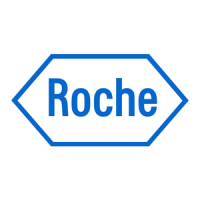Roche Diagnostics
Operator’s Manual · Version 3.1 A-27
Cedex Bio System 2 Introduction to the instrument
Daily operation
Calibration sequence
The calibration sequence is an application definition. It defines the manner in which
the system determines when a calibration is due.
The calibration interval defines the on-board stability of a reagent.
One of the following sequences applies to each reagent set:
No Interval You perform calibration whenever you think fit. Use this value if you are sure that the
reagent is stable until it is empty and you replace it with a new one. Calibration is due
whenever a new reagent set is loaded on the instrument.
Interval Only You perform calibration only when the interval has expired.
Each Lot and Interval You perform calibration whenever the fist reagent of a new lot is loaded and then
each time the interval has expired.
In this case, the interval is related to the date when the lot calibration was generated,
and it (re)starts whenever you calibrate a reagent set (as a result of interval expiry or
starting a new lot).
You can turn off the interval check by defining its duration as 0 (zero).
Each Set and Interval You perform calibration whenever a new reagent is loaded and when the interval has
expired.
The interval starts again whenever you calibrate a reagent set because the interval had
expired or a new lot was started.
You can turn off the interval check by defining its duration as 0 (zero).
Day Trigger/Event Task Result used Set Cal. type Cal. Usage
1 NA 1. Place first reagent set of new lot.
2. Calibrate set L1/1.
Result 1 L1/1 Lot Current
2 Reagent empty. 1. Remove set L1/1.
2. Place new set L1/2.
Result 1 L1/2
L1/1
Set
Lot
Current
-
Reagent empty. Replace set whenever it is empty. Result 1 Set Current
5 Interval expired. Calibrate current set L1/n. Result 2 L1/n
L1/n-1
Set
Set
Current
Obsolete
6 Reagent empty. Place new set L1/n+1. Result 1 L1/n+1
L1/n
Set
Set
Current
Obsolete
8 Reagent empty.
New lot.
1. Remove set L1/n+1.
2. Place new set, which is the first set of a new lot.
3. Calibrate set L2/1.
Result 3 L2/1
L1/1
L1/n+1
Lot
Lot
Set
Current
Obsolete
Obsolete
Reagent empty. Place new set L2/2. Result 3 L2/2
L2/1
Set
Lot
Current
-
10 Interval expired. Calibrate current set L2/n. Result 4 L2/n
L2/n-1
Set
Set
Current
Obsolete
11 Reagent empty. Place new set L2/n+1. Result 3 L2/n+1
L2/n
Set
Set
Current
Obsolete
Table A-2 Example for set change and calibration types
Roche recommend not to change the calibration sequence.

